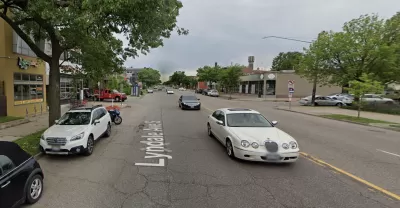In the Twin Cities, traffic engineers are reconsidering traffic congestion on four-lane arterials in the face of unrelenting tragedy on these car-centric corridors. Road diets, designed for safety, are now a more tenable proposition.

Bill Lendeke reports from the Twin Cities region in Minnesota, where traffic fatalities are pressuring local officials to commit to changes on unsafe four-lane arterials where drivers inflict the most damage.
Lyndale Avenue in provides the scene for the story, as the location of a recent tragedy where a driver struck and killed 54-year-old Theodore Ferrera on October 13.
At first glance, the idea of change on Lyndale might seem hopeless. The Hennepin County arterial street has very high traffic volumes — more than 24,000 cars a day. But recent moves by Ramsey and Hennepin Counties this year are signs that the conventional wisdom about four-lane roads might be changing. Both counties have become more aggressive about implementing three-lane “road diets,” as engineers and policy makers have begun to push the boundaries of where safety measures might work. These new designs, on streets like Broadway NE and Maryland Avenue, might be a sign of a safer approach to urban streets in the Twin Cities.
According to Lindeke, four-lane, undivided roads in walkable urban neighborhoods are the most deadly streets in the region. The street design is intended to give cars room to speed and maneuver around slower or stopped vehicles. Adding pedestrians to the mix has deadly consequences. It took a certain traffic volume, below 16,000 car trips a day, to convince traffic engineers to commit to a road diet on streets like this in the region, due to the desire to keep moving cars traffic moving at high speeds. The old traffic regime, however, is coming to end.
"This year, at least in the Twin Cities, the industry standards are beginning to change. In the wake of persistent crashes, first Ramsey and now Hennepin County are implementing four-to-three-lane conversions on arterials with far more traffic than in years past," explains Lindeke.
FULL STORY: Risky Hennepin and Ramsey County streets are increasingly being put on ‘road diets’

Alabama: Trump Terminates Settlements for Black Communities Harmed By Raw Sewage
Trump deemed the landmark civil rights agreement “illegal DEI and environmental justice policy.”

Planetizen Federal Action Tracker
A weekly monitor of how Trump’s orders and actions are impacting planners and planning in America.

The 120 Year Old Tiny Home Villages That Sheltered San Francisco’s Earthquake Refugees
More than a century ago, San Francisco mobilized to house thousands of residents displaced by the 1906 earthquake. Could their strategy offer a model for the present?

In Both Crashes and Crime, Public Transportation is Far Safer than Driving
Contrary to popular assumptions, public transportation has far lower crash and crime rates than automobile travel. For safer communities, improve and encourage transit travel.

Report: Zoning Reforms Should Complement Nashville’s Ambitious Transit Plan
Without reform, restrictive zoning codes will limit the impact of the city’s planned transit expansion and could exclude some of the residents who depend on transit the most.

Judge Orders Release of Frozen IRA, IIJA Funding
The decision is a victory for environmental groups who charged that freezing funds for critical infrastructure and disaster response programs caused “real and irreparable harm” to communities.
Urban Design for Planners 1: Software Tools
This six-course series explores essential urban design concepts using open source software and equips planners with the tools they need to participate fully in the urban design process.
Planning for Universal Design
Learn the tools for implementing Universal Design in planning regulations.
Clanton & Associates, Inc.
Jessamine County Fiscal Court
Institute for Housing and Urban Development Studies (IHS)
City of Grandview
Harvard GSD Executive Education
Toledo-Lucas County Plan Commissions
Salt Lake City
NYU Wagner Graduate School of Public Service





























